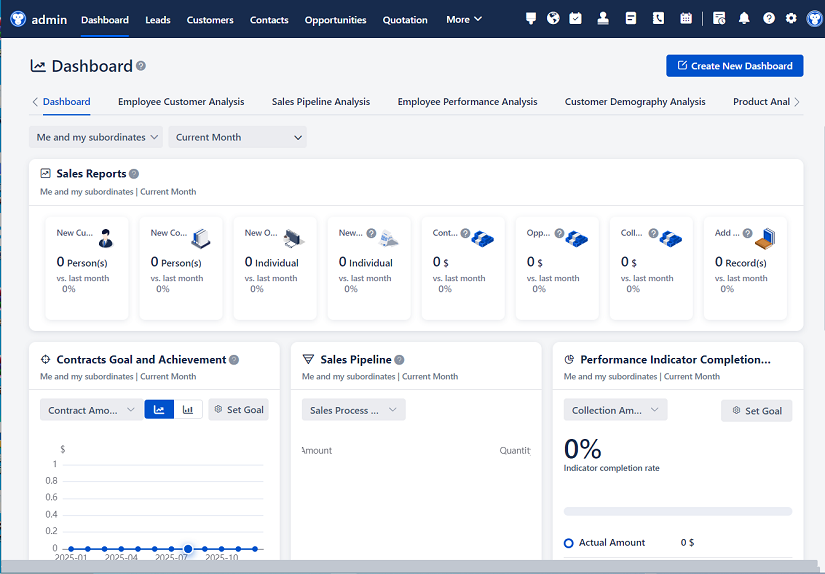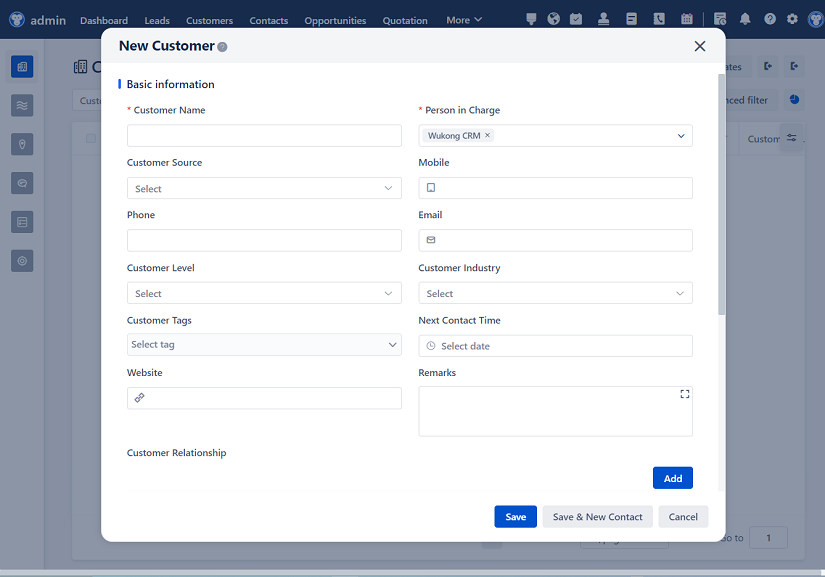
△Click on the top right corner to try Wukong CRM for free
Sure, here’s an article on the risks of customizing a CRM system, written in a conversational tone.
Hey there! So, you're thinking about customizing your CRM system, huh? That's a big step, and it can really make a difference in how your business operates. But before you dive in, let’s chat about some of the risks you might face. Trust me, it’s better to be prepared than to get caught off guard.

First things first, one of the biggest risks is that customization can get pretty expensive. I mean, we’re talking about adding features, tweaking existing ones, and maybe even integrating with other systems. All of this adds up, and if you’re not careful, you could end up spending way more than you initially planned. It’s like when you go to the grocery store for just a few items, but somehow end up with a cart full of stuff. You know what I mean?

Another thing to keep in mind is that the more you customize, the more complex your system becomes. And complexity can lead to all sorts of issues. For example, it might become harder to maintain and update the system. Imagine having a car with a ton of custom parts. Sure, it looks cool, but when something goes wrong, finding the right mechanic and parts can be a real headache. The same goes for your CRM. If you over-customize, you might find yourself in a situation where only a few experts can help you, and they might charge a premium for their services.
Speaking of updates, another risk is that your customizations might not play nicely with future updates from the CRM provider. Think about it: the CRM company is always working on new features and improvements, and they release updates regularly. But if you’ve made a lot of changes, those updates might break your custom features or cause compatibility issues. It’s like when you have a perfectly good phone, but the latest software update messes everything up. Frustrating, right?
And then there’s the issue of data integrity. When you start customizing, you might inadvertently introduce bugs or errors that affect the accuracy and reliability of your data. This is a big deal because your CRM is supposed to be the single source of truth for your customer information. If the data gets messed up, it can lead to all sorts of problems, from misinformed decisions to unhappy customers. It’s like if you had a recipe book, but someone accidentally spilled coffee on it, and now you can’t read the ingredients properly. Not good!
Another risk is that customization can slow down the performance of your CRM. You see, every time you add a new feature or tweak an existing one, you’re adding more code and processes that the system has to handle. Over time, this can make your CRM sluggish and unresponsive. It’s like having a computer with too many programs running at once. Eventually, it starts to lag, and you end up frustrated and less productive.
Now, let’s talk about user adoption. Customization can sometimes make the system more difficult for your team to use. If the interface becomes too cluttered or confusing, your employees might resist using it. And if they don’t use it, well, what’s the point, right? It’s like getting a new kitchen gadget that’s supposed to make cooking easier, but it’s so complicated that you end up sticking with your old methods. Not exactly the outcome you were hoping for.
There’s also the risk of vendor lock-in. When you heavily customize a CRM, you might find it hard to switch to a different system in the future. This is because your customizations are often specific to the platform you’re using, and moving them to a new system can be a huge hassle. It’s like building a house with unique, custom-made furniture. If you ever decide to move, you’ll have a tough time finding a new place that fits all your special pieces. Not ideal, especially if you want to stay flexible and open to new options.
Lastly, let’s not forget about security. Customizing a CRM can sometimes create vulnerabilities that hackers can exploit. If you’re not careful, you might unintentionally open up backdoors that put your sensitive data at risk. It’s like leaving a window open in your house. Sure, it lets in fresh air, but it also makes it easier for intruders to get in. You definitely don’t want that happening with your CRM.
So, there you have it. Customizing a CRM system can bring a lot of benefits, but it’s important to be aware of the potential risks. Make sure you weigh the pros and cons carefully and have a solid plan in place before you start making changes. And if you need help, don’t hesitate to reach out to experts who can guide you through the process. After all, it’s better to be safe than sorry, right?
Q&A:
Q: How can I avoid overspending on CRM customization? A: Great question! One way to avoid overspending is to clearly define your needs and set a budget upfront. Prioritize the most essential features and get a detailed quote from your CRM provider or a third-party developer. Also, consider phasing the customization over time rather than doing everything at once. This way, you can monitor costs and make adjustments as needed.
Q: What should I do if my customizations break after a CRM update? A: If your customizations break after an update, the first step is to contact your CRM provider or the developer who did the custom work. They can help diagnose the issue and provide a fix. In the meantime, you might need to roll back to a previous version of the CRM until the problem is resolved. It’s also a good idea to test updates in a sandbox environment before applying them to your live system.
Q: How can I ensure that my custom CRM remains user-friendly? A: To keep your custom CRM user-friendly, involve your team in the design and testing process. Get their feedback on the interface and functionality, and make sure the changes align with their workflows. Keep the interface clean and intuitive, and provide training and support to help them adapt to the new features. Regularly gather feedback and make iterative improvements based on their input.
Q: Is it possible to avoid vendor lock-in when customizing a CRM? A: Yes, it is possible to minimize vendor lock-in. One approach is to use standard APIs and integrations that are widely supported. This way, if you need to switch to a different CRM in the future, you can more easily transfer your data and customizations. Additionally, document all your customizations and keep a record of the changes. This will make it easier to replicate or migrate them to a new system if needed.
Q: How can I ensure the security of my customized CRM? A: Security is crucial! Make sure to follow best practices for securing your CRM, such as using strong passwords, enabling two-factor authentication, and keeping your system and plugins up to date. Work with a reputable developer who follows secure coding practices and conduct regular security audits. Also, limit access to sensitive data and features to only those who need it, and train your team on security best practices.
I hope these answers help! If you have any more questions, feel free to ask. Good luck with your CRM customization!
Related links:
Free trial of CRM
Understand CRM system
AI CRM Systems

△Click on the top right corner to try Wukong CRM for free